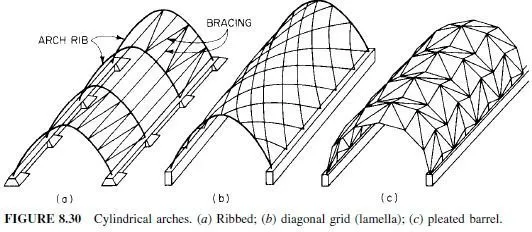A basic requirement of all welds is thorough fusion of weld and base metal and of successive layers of weld metal. In addition, welds should not be handicapped by craters, undercutting, overlap, porosity, or cracks. (AWS D1.1 and D1.5 give acceptable tolerances for these defects.)
If craters, excessive concavity, or undersized welds occur in the effective length of a weld, they should be cleaned and filled to the full cross section of the weld. Generally, all undercutting (removal of base metal at the toe of a weld) should be repaired by depositing weld metal to restore the original surface. Overlap (a rolling over of the weld surface with lack of fusion at an edge), which may cause stress concentrations, and excessive convexity should be reduced by grinding away of excess material (see Figs. 5.19 and 5.20). If excessive
porosity, excessive slag inclusions, or incomplete fusion occur, the defective portions should be removed and rewelded. If cracks are present, their extent should be determined by acid etching, magnetic-particle inspection, or other equally positive means. Not only the cracks but also sound metal 2 in beyond their ends should be removed and replaced with the weld metal. Use of a small electrode for this purpose reduces the chances of further defects due to shrinkage. An electrode not more than 5â„32 in in diameter is desirable for depositing weld metal to compensate for size deficiencies.
AWS D1.1 limits convexity C to the values in Table 5.16. AWS D1.5 limits C to 0.06 in plus 7% of the measured face of the weld.
Weld-quality requirements should depend on the job the welds are to do. Excessive requirements are uneconomical. Size, length, and penetration are always important for a stresscarrying weld and should completely meet design requirements. Undercutting, on the other
hand, should not be permitted in main connections, such as those in trusses and bracing, but small amounts might be permitted in less important connections, such as those in platform framing for an industrial building. Type of electrode, similarly, is important for stresscarrying welds but not so critical for many miscellaneous welds. Again, poor appearance of a weld is objectionable if it indicates a bad weld or if the weld will be exposed where aesthetics is a design consideration, but for many types of structures, such as factories, warehouses, and incinerators, the appearance of a good weld is not critical. A sound weld is important. But a weld entirely free of porosity or small slag inclusions should be required only when the type of loading actually requires this perfection.
Welds may be inspected by one or more methods: visual inspection; nondestructive tests, such as ultrasonic, x-ray, dye penetration, and magnetic particle; and cutting of samples from finished welds. Designers should specify which welds are to be examined, extent of the examination, and methods to be used.




